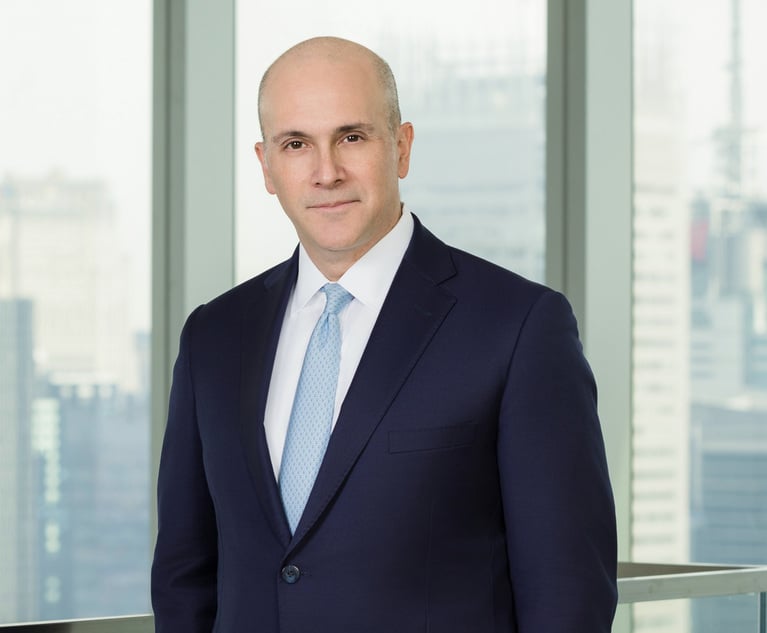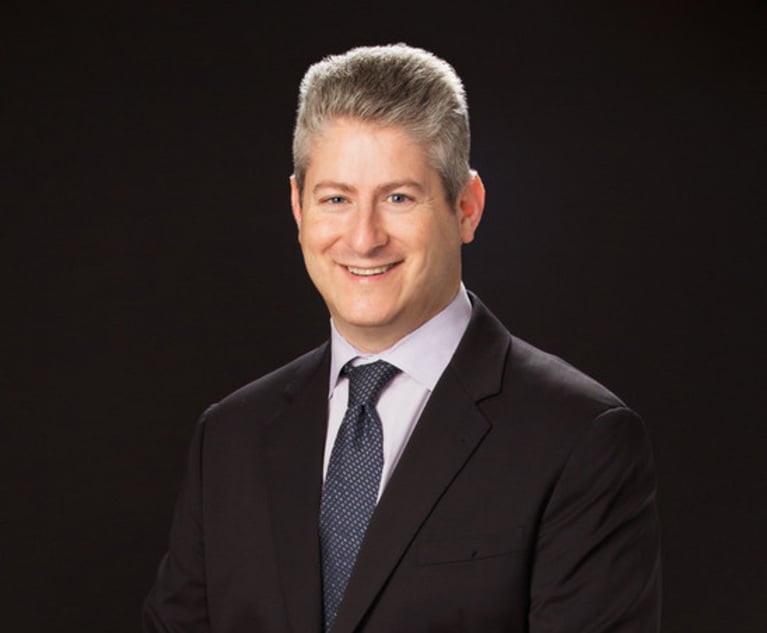Historic Clock, an Interior Landmark, Must Be Preserved As Is, Panel Rules
Advocates for the clock say the decision is a monumental one: They argue that it makes clear that the city Landmarks Preservation Commission may prevent the residential privatization of interior landmarks, of which there are 117 across New York City.
December 05, 2017 at 05:50 PM
6 minute read
 The clock on top of the landmarked 346 Broadway.
The clock on top of the landmarked 346 Broadway.Handout photo.
The historic four-faced clock perched atop the Clock Tower Building in lower Manhattan has won a precedent-setting battle over its preservation: A state appeals court has ruled that a private developer may not undo its great mechanical inner workings in order to create a giant triplex condominium in the space around it.
Advocates for the clock say the decision is a monumental one: They argue that it makes clear that the city Landmarks Preservation Commission may prevent the residential privatization of interior landmarks, of which there are 117 across New York City, including the majestic clock, which sits atop the western end of a neo-Italian Renaissance style building at 346 Broadway.
Meanwhile, lawyers for the private developer have already vowed to appeal to the state's highest court over the decision, which rejects their plans for the luxury condominium.
The “historically significant functioning mechanism” of the clock, which is said to be one of the largest mechanical tower clocks in the world, and which is part of a designated interior city landmark, must be preserved and kept operating, ruled the majority of a divided 3-2 Appellate Division, First Department, panel in Matter of Save America's Clocks v. City of New York, 101109/15.
The clock, wound every week by men who muscle a giant crank, counts down time using a 1,000-pound weight that drops inch by inch through a 14-story glass-and-wood chute, according to the court and news reports. It was restored in the 1980s by Marvin Schneider, now the city's clock master and one of the plaintiffs in the Article 78 proceeding aimed at preserving the clock and public access to it. The massive timepiece, which has rung out the hours for more than 100 years, features a 5,000-pound bell hanging over a spiral staircase. It is also one of the world's few remaining giant clocks that must be wound to work.
“Indeed, the only other clock in the world with a similar mechanism is the one atop Westminster Palace known as Big Ben,” wrote Justice Ellen Gesmer in the opinion.
The developer, Civic Center Community Group Broadway, which bought the Clock Tower Building in 2013 for $145 million, had proposed converting the clock to electric power. Its plans, though, had included keeping intact and restoring the clock faces themselves, as well as the prized 19th century physical mechanism—in a nonoperational state—that once powered the great clock.
Those plans were not enough, however. In a 20-page majority decision penned by Gesmer, the majority justices decided that Civic Center Community Group's plans ran afoul of the city's Landmarks Law. The functioning mechanism inside the clock “is a perfect example of the very reason the Landmarks Law exists, because the 'protection, . . . perpetuation, and use of [objects] of special character or special historical or aesthetic interest or value is a public necessity,'” Gesmer wrote, quoting Landmarks Law § 25-301[b]).
Joined by Justices Rolando Acosta and Barbara Kapnick, she also declared that the Landmarks Preservation Commission has the authority under the Landmarks Law to regulate the clock's mechanism for two reasons.
First, such a result “effectuates the statutory purposes,” she said. And second, the Landmarks Law “clearly gives the LPC authority to require the owner to run the clock by its still functioning mechanism and to deny the request to electrify it,” she added.
“Indeed, there would be little point in designating the machinery as a landmark without an expectation that it would continue to operate for so long as it can,” Gesmer wrote in the Nov. 30 opinion, adding, “As assistant city clock master Forest Markowitz commented at [a] hearing, disconnecting the mechanism and electrifying the landmarked clock would be analogous to replacing the engine of a classic car with a modern engine: 'He would now have a Chevy Volt and not a 1948 Dodge.'”
The majority's ruling, meanwhile, overruled a previous decision by the Commission to allow the Civic Center Community Group to effect its plans for the triplex condominium surrounding the clock.
But in dissent, Justice Marcy Kahn, joined by Justice Peter Tom, wrote that “the Landmarks Law does not explicitly state that the owner of a building containing an interior landmark is required to maintain public access to that landmark in perpetuity, however.”
“The majority's contrary view, that an owner of an interior landmark is required to maintain public accessibility in perpetuity, is without support in settled law,” she added.
Kahn also wrote that “prior to issuing the [approval], the LPC held extensive hearings on the public access [to the interior landmark] issue, and the record evidence provides ample support for its determination. As is evident from the record, in order to provide the public with access to the clocktower suite, the owners/occupants of the residential unit would be required to allow members of the public to traverse their private triplex residence in order to reach the clocktower gallery and mechanism room.”
In a phone interview, Michael Hiller of Hiller P.C., the lawyer for a group of preservationist organizations and city employees and historians who opposed altering the clock, said, “We're talking about the privatization of landmark properties, any one of which could have been converted to a residential apartment in the absence of this decision.”
Then, referring to a major U.S. Supreme Court decision that addressed the protection of exterior landmarks, he also said that “this decision is to interior landmarks, what Penn Central [Transportation v. New York City, 438 U.S. 104 (1978)] is to the exterior landmarks.”
But Jeffrey Braun, counsel at Kramer Levin Naftalis & Frankel representing the Civic Center Community Group, said in an email, “We agree with the two Justices who dissented and believe that they analyzed the law correctly. … We are convinced that the majority's decision misinterprets the Landmarks Law in multiple significant ways and, if it is allowed to stand, would expose the whole system of interior landmarking to a constitutional attack that would lead to the entire system's invalidation. We simply do not believe that the Landmarks Preservation Commission has the power to require a building owner to continue to allow the public to enter its building's interior spaces, and certainly the commission itself never has believed that it has that power. We also believe that electrifying the clock would perpetually guaranty that the public will be able to enjoy an illuminated clock.”
Nick Paolucci, a spokesman for the city's Law Department, said that “the court was divided 3-2, and we are evaluating next steps.”
This content has been archived. It is available through our partners, LexisNexis® and Bloomberg Law.
To view this content, please continue to their sites.
Not a Lexis Subscriber?
Subscribe Now
Not a Bloomberg Law Subscriber?
Subscribe Now
NOT FOR REPRINT
© 2025 ALM Global, LLC, All Rights Reserved. Request academic re-use from www.copyright.com. All other uses, submit a request to [email protected]. For more information visit Asset & Logo Licensing.
You Might Like
View All

Cooley Promotes NY Office Leader to Global Litigation Department Chair

NY Judge Resigns After Avoiding Jury Duty by Telling Court He Couldn't Be Impartial

Charlie Javice Jury Will Not See Her Texts About Elizabeth Holmes
Trending Stories
- 1Rejuvenation of a Sharp Employer Non-Compete Tool: Delaware Supreme Court Reinvigorates the Employee Choice Doctrine
- 2Mastering Litigation in New York’s Commercial Division Part V, Leave It to the Experts: Expert Discovery in the New York Commercial Division
- 3GOP-Led SEC Tightens Control Over Enforcement Investigations, Lawyers Say
- 4Transgender Care Fight Targets More Adults as Georgia, Other States Weigh Laws
- 5Roundup Special Master's Report Recommends Lead Counsel Get $0 in Common Benefit Fees
Who Got The Work
J. Brugh Lower of Gibbons has entered an appearance for industrial equipment supplier Devco Corporation in a pending trademark infringement lawsuit. The suit, accusing the defendant of selling knock-off Graco products, was filed Dec. 18 in New Jersey District Court by Rivkin Radler on behalf of Graco Inc. and Graco Minnesota. The case, assigned to U.S. District Judge Zahid N. Quraishi, is 3:24-cv-11294, Graco Inc. et al v. Devco Corporation.
Who Got The Work
Rebecca Maller-Stein and Kent A. Yalowitz of Arnold & Porter Kaye Scholer have entered their appearances for Hanaco Venture Capital and its executives, Lior Prosor and David Frankel, in a pending securities lawsuit. The action, filed on Dec. 24 in New York Southern District Court by Zell, Aron & Co. on behalf of Goldeneye Advisors, accuses the defendants of negligently and fraudulently managing the plaintiff's $1 million investment. The case, assigned to U.S. District Judge Vernon S. Broderick, is 1:24-cv-09918, Goldeneye Advisors, LLC v. Hanaco Venture Capital, Ltd. et al.
Who Got The Work
Attorneys from A&O Shearman has stepped in as defense counsel for Toronto-Dominion Bank and other defendants in a pending securities class action. The suit, filed Dec. 11 in New York Southern District Court by Bleichmar Fonti & Auld, accuses the defendants of concealing the bank's 'pervasive' deficiencies in regards to its compliance with the Bank Secrecy Act and the quality of its anti-money laundering controls. The case, assigned to U.S. District Judge Arun Subramanian, is 1:24-cv-09445, Gonzalez v. The Toronto-Dominion Bank et al.
Who Got The Work
Crown Castle International, a Pennsylvania company providing shared communications infrastructure, has turned to Luke D. Wolf of Gordon Rees Scully Mansukhani to fend off a pending breach-of-contract lawsuit. The court action, filed Nov. 25 in Michigan Eastern District Court by Hooper Hathaway PC on behalf of The Town Residences LLC, accuses Crown Castle of failing to transfer approximately $30,000 in utility payments from T-Mobile in breach of a roof-top lease and assignment agreement. The case, assigned to U.S. District Judge Susan K. Declercq, is 2:24-cv-13131, The Town Residences LLC v. T-Mobile US, Inc. et al.
Who Got The Work
Wilfred P. Coronato and Daniel M. Schwartz of McCarter & English have stepped in as defense counsel to Electrolux Home Products Inc. in a pending product liability lawsuit. The court action, filed Nov. 26 in New York Eastern District Court by Poulos Lopiccolo PC and Nagel Rice LLP on behalf of David Stern, alleges that the defendant's refrigerators’ drawers and shelving repeatedly break and fall apart within months after purchase. The case, assigned to U.S. District Judge Joan M. Azrack, is 2:24-cv-08204, Stern v. Electrolux Home Products, Inc.
Featured Firms
Law Offices of Gary Martin Hays & Associates, P.C.
(470) 294-1674
Law Offices of Mark E. Salomone
(857) 444-6468
Smith & Hassler
(713) 739-1250






